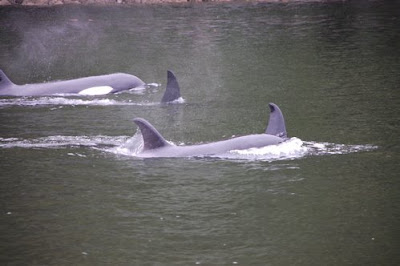
or
What’s white in the morning, black in the evening,
and black and white in between?
and black and white in between?
The day began spectacularly, Thomas waking Elizabeth at first light with “Quick! White bear on the beach!” Year after year we’ve been looking for the Kermode or White Spirit Bear. And finally this beautiful morning in Butedale on our way north, we were given this gift. We watched through binoculars as – I’ll use the inclusive she - she ambled along the rocks towards a distant beach, looking here and there and under rocks for things to eat.


When she arrived at the beach we hopped in the dinghy with the camera. She didn’t seem too worried about us, just kept on her morning walk. After walking inside the woods for a while she came out onto the nearer beach, where there is debris left from the former cannery. Here she is eating sedges by an old boiler

Kermode bears are a special variety of black bear found only in certain isolated places. Princess Royal Island is the mist shrouded magical island most known for the Kermode Bear.

The falls at Butedale, a former cannery located on Princess Royal.
These days often the only person here is Lou, the dedicated caretaker.
There have been white bear sightings in other places - Gribbel Island, Roderick Island, and our Aunt Chris saw the one that was sometimes around the dump in Terrace, BC, until somebody shot it. Environmentalists have been sharing the story of the Spirit Bear as a way to raise awareness of another wonder of creation, and increase public will to protect habitat. Although Princess Royal Island has been protected, there is still much logging and habitat is threatened.
We’ve learned much about the Spirit Bear in The Great Bear Rainforest, by Ian and Karen McAllister, and The Spirit Bear, by Charles Russell.
A bear researcher we met in Klemtu some years ago told us places where he’d seen the white bear. This estuary in Bottleneck Inlet, Roderick Island, is where we’d hoped to find her.
We found signs of what she may have been eating.
 These sedges have been munched on by bear or maybe geese.
These sedges have been munched on by bear or maybe geese.This is Lyngby's sedge, important for bears in spring
as they contain 25% raw protein.
Salmon are the lifeblood of the coast. Spawning salmon carcasses are carried for miles up the creeks and into the forest, nourishing many species
We didn’t find our spirit bear in this beautiful inlet and estuary, but when we did see her, she carried the awe and wonder of her environment with her.
And the wonder continued that day. White bear in the morning, black in the evening…
where we anchored by Verny Falls.
…and black and white in between.
We traveled for a while in the afternoon with a pod of orcas in Grenville Channel












1 comment:
Looking at the amazing photos and reading your words reminded me of the wonderful time Erica and I had with you and Thomas. Love you guys.
Scott and Erica. :)
Post a Comment